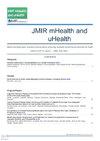Assessment of Eye Care Apps for Children and Adolescents Based on the Mobile App Rating Scale: Content Analysis and Quality Assessment
IF 5.4
2区 医学
Q1 HEALTH CARE SCIENCES & SERVICES
引用次数: 0
Abstract
Background: In China, the current situation of myopia among children and adolescents is very serious. Prevention and control of myopia are inhibited by the lack of medical resources and the low awareness about eye care. Nevertheless, mobile apps provide an effective means to solve these problems. Since the health app market in China is still immature, it has become particularly important to conduct a study to assess the quality of eye-care apps to facilitate the development of better eye-care service strategies. Objective: This study aimed to evaluate the quality, functionality, medical evidence, and professional background of eye-care apps targeting children and adolescents in the Chinese app stores. Methods: A systematic search on iOS and Android app stores was performed to identify eye-care apps for children and adolescents. The general characteristics, development context, and functional features of the apps were described. Quality assessment of the apps was completed by 2 independent researchers using the Mobile App Rating Scale. Results: This study included 29 apps, of which 17 (59%) were developed by commercial organizations and 12 (41%) had a design with relevant scientific basis. The main built-in functions of these apps include self-testing (18/29, 62%), eye exercises (16/29, 55%), and eye-care education (16/29, 55%). The mean overall quality of eye-care apps was 3.49 (SD 0.33), with a score ranging from 2.89 to 4.39. The overall Mobile App Rating Scale score exhibited a significant positive correlation with the subscale scores (r=0.81-0.91; P<.001). In addition, although most apps provided basic eye-care features, there are some deficiencies. For example, only a few apps were developed with the participation of medical organizations or professional ophthalmologists, and most of the apps were updated infrequently, failing to provide the latest eye-care information and technology in a timely manner. Conclusions: In general, the quality of eye-care apps for children and teenagers in Chinese app stores is good. These apps fulfill users’ needs for eye-care services to a certain extent, but they still suffer from insufficient medical background, low user engagement, and untimely updates. In order to further improve the effectiveness of eye-care apps, cooperation with medical institutions and professional ophthalmologists should be strengthened to enhance the scientific and authoritative nature of the apps. At the same time, interactive features and regular updates should be added to enhance user participation and the continuity of the apps. This study provides a reference for future development or improvement of eye-care apps, which can help promote myopia prevention and control.基于移动应用程序评分量表的儿童和青少年眼科护理应用程序评估:内容分析与质量评估
背景:中国儿童青少年近视现状十分严峻。医疗资源的匮乏和护眼意识的淡薄阻碍了近视防控工作的开展。然而,手机应用程序为解决这些问题提供了有效途径。由于中国的健康应用程序市场尚不成熟,因此开展一项评估护眼应用程序质量的研究以促进制定更好的护眼服务策略就显得尤为重要。研究目的本研究旨在评估中国应用程序商店中针对儿童和青少年的护眼应用程序的质量、功能、医学证据和专业背景。方法:对 iOS 和 Android 应用程序进行系统检索:对 iOS 和 Android 应用程序商店进行系统搜索,以确定针对儿童和青少年的护眼应用程序。对应用程序的一般特征、开发背景和功能特点进行了描述。两名独立研究人员使用移动应用程序评分量表完成了应用程序的质量评估。研究结果本研究包括 29 款应用程序,其中 17 款(59%)由商业机构开发,12 款(41%)的设计具有相关科学依据。这些应用程序的主要内置功能包括自我测试(18/29,62%)、眼保健操(16/29,55%)和护眼教育(16/29,55%)。护眼应用程序总体质量的平均值为 3.49(标准差为 0.33),得分范围在 2.89 至 4.39 之间。移动应用评分量表的总分与各分量表得分呈显著正相关(r=0.81-0.91;P<.001)。此外,尽管大多数应用程序都提供了基本的护眼功能,但也存在一些不足之处。例如,只有少数应用程序是在医疗组织或专业眼科医生的参与下开发的,而且大多数应用程序的更新频率较低,不能及时提供最新的护眼信息和技术。结论总体而言,中国应用程序商店中的儿童和青少年护眼应用程序质量较好。这些应用在一定程度上满足了用户的护眼服务需求,但仍存在医疗背景不足、用户参与度低、更新不及时等问题。为了进一步提高护眼类应用的效果,应加强与医疗机构和专业眼科医生的合作,增强应用的科学性和权威性。同时,应增加互动功能和定期更新,提高用户参与度和应用程序的延续性。本研究为今后开发或改进护眼应用程序提供了参考,有助于促进近视防控工作。
本文章由计算机程序翻译,如有差异,请以英文原文为准。
求助全文
约1分钟内获得全文
求助全文
来源期刊

JMIR mHealth and uHealth
Medicine-Health Informatics
CiteScore
12.60
自引率
4.00%
发文量
159
审稿时长
10 weeks
期刊介绍:
JMIR mHealth and uHealth (JMU, ISSN 2291-5222) is a spin-off journal of JMIR, the leading eHealth journal (Impact Factor 2016: 5.175). JMIR mHealth and uHealth is indexed in PubMed, PubMed Central, and Science Citation Index Expanded (SCIE), and in June 2017 received a stunning inaugural Impact Factor of 4.636.
The journal focusses on health and biomedical applications in mobile and tablet computing, pervasive and ubiquitous computing, wearable computing and domotics.
JMIR mHealth and uHealth publishes since 2013 and was the first mhealth journal in Pubmed. It publishes even faster and has a broader scope with including papers which are more technical or more formative/developmental than what would be published in the Journal of Medical Internet Research.
 求助内容:
求助内容: 应助结果提醒方式:
应助结果提醒方式:


